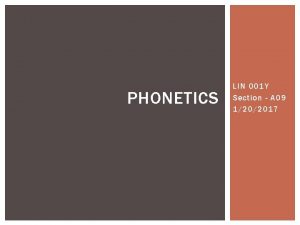Hemispheric Differences in the Recognition of Environmental Sounds

- Slides: 1

Hemispheric Differences in the Recognition of Environmental Sounds ACOUSTICS 2008/462 PARIS Julio González a. Universitat a and Jaume I, Castellon de la Plana, Spain. Conor T. b. Cleveland c b M Lennan State University, Cleveland, OH, USA. ABSTRACT In the visual domain, Marsolek and colleagues have found evidence for two dissociable and parallel neural subsystems underlying object recognition: an abstractcategory subsystem that operates more effectively in the LH and is less sensitive to specific surface characteristics of the stimuli, and a specific-exemplar subsystem that operates more effectively in the RH and is more sensitive to specific stimulus characteristics. In the present study, we tested this hypothesis in the auditory domain by conducting two long-term repetition-priming experiments on the recognition of environmental sounds. Participants attempted to identify target sounds from an initial 750 ms sound stem presented monaurally. Target stems were primed by either an identical or a different exemplar sound (e. g. , the same or different tokens of an accordion). In Exp. 2 white noise was simultaneously administered to the opposite ear. In both experiments, we obtained an exemplar-specificity effect when sounds were presented to the left ear (RH), but not when sounds were presented to the right ear (LH), consistent with Marsolek’s framework. In the visual domain, Marsolek and colleagues have found evidence for their claim that two dissociable and parallel neural subsystems underlie abstract and specific recognition of objects (Burgund & Marsolek, 2000; Marsolek, 1999; Marsolek & Burgund, 2003), word forms, pseudoword forms, and letter-like forms. According to their theory, an abstractcategory subsystem operates more effectively in the left hemisphere (LH) and is less sensitive to the specific surface characteristics of the stimuli, whereas a specificexemplar subsystem operates more effectively in the right hemisphere (RH) and is more sensitive to specific stimulus characteristics. Same-Exemplar Primed 1 st BLOCK (BINAURAL) The strongest support for the two-systems hypothesis comes from studies using the long-term repetition-priming paradigm, in which participants must respond to an initial block of stimuli. After a short distracter task, participants are presented with a second block of stimuli, in which some of the stimuli from the first block are repeated. Typically, performance for repeated stimuli is better than performance for new stimuli (priming effect). However, if the first and second presentations (prime and target, respectively) mismatch on some dimension, the priming effect may be attenuated, and this attenuation is referred to as specificity (or a specificity effect). Distracter task Marsolek (1999) has reported distinct patterns of specificity in the two cerebral hemispheres for object recognition. Participants named objects (e. g. , piano) presented in either the left (RH) or right (LH) visual field during a test phase after having viewed centrally presented same-exemplar or different-exemplar objects (e. g. , two different exemplars of a piano) during an initial encoding phase. Equivalent priming was obtained in the same- and different-exemplar conditions when test objects were presented to the LH, but priming was reduced in the different-exemplar condition (i. e. , specificity) when test objects were presented to the RH. A similar pattern of hemispheric differences has also been obtained for the recognition of objects previously primed by a same or different depth-orientation view (Burgund & Marsolek, 2000). In the present study, we tested Marsolek's hypothesis in the auditory domain by performing two long-term repetition-priming experiments on the recognition of environmental sounds. There are reasons to believe that two dissociable neural subsystems underlying abstract and specific perception may not be limited to the visual domain. Indeed, we recently obtained hemispheric differences in specificity effects in spoken word recognition (González & Mc. Lennan, 2007) in line with the Marsolek's data in visual word recognition. Unprimed Different-Exemplar Primed noise Exp. 2 2 Exp. sound stem (750 ms) noise Exp. 2 sound stem (750 ms) 2 nd BLOCK (MONAURAL) Fig. 1. Long-term repetition-priming paradigm. The combination of the three levels of prime type (same-exemplar, differentexemplar, and unprimed) and the ears of sound stem presentation (left, right) results in six within-participant conditions. EXPERIMENT 1 RESULTS AND CONCLUSIONS (Fig. 2) Method Participants. In each experiment 24 participants of both sexes were voluntarily recruited from the University Jaume I of Castellón (Spain) for course credit. All participants were right-handed (Edinburgh Handedness Inventory, Oldfield, 1971) native speakers of Spanish with no reported history of speech or hearing disorders. None participated in more than one experiment. Materials. The stimuli consisted of 24 digitized target sounds selected from the Marcell et al. 's (2000) database representing a variety of acoustic events, such as sounds produced by animals, people, musical instruments, transportation, tools, and other objects (16 -bit. WAV files at a sampling rate of 22, 050 Hz). Following Shafiro and Gygi's (2004) guidelines, an additional set of 24 digitized sounds was selected from a variety of sound databases. Durations of the sound files ranged from 1. 1 – 5. 9 s. All audio files were equated in root-mean-square (RMS) amplitude. Auditory stems were created by digitally truncating each target sound so that only the initial 750 ms were preserved. Design and Procedure. Following a similar procedure to that used in Chiu (2000), the experiment consisted of two blocks of stimuli presented to listeners (Fig. 1). In the first block, stimuli were presented binaurally for identification. After a short distracter task, participants received the second block (test phase) and were instructed to identify target sounds from an initial 750 ms sound stem. Stems were presented monaurally in random order: half were presented to the left ear (right hemisphere RH), and half to the right ear (left hemisphere LH). 8 of stems were primed by the same exemplar sound during the first block (same-exemplar condition), 8 were primed by a different exemplar (different-exemplar condition), and 8 were unprimed (control condition). The experimental design was an orthogonal combination 3 x 2 of prime type (same-exemplar, differentexemplar, and control) by ear of target stem presentation (left, right), resulting in six within-participant conditions, as shown in Fig. 1. Six stimulus lists were created to ensure that each target stem was assigned to every possible condition. EXP. 1: Crucially, the difference between the same-exemplar and different-exemplar conditions (0. 64 and 0. 57, respectively) was not significant when the target stems were presented to the right ear (both ts <1), but this difference was significant (0. 67 and 0. 50) when the target stems were presented to the left ear, t 1(23) = 3. 56, p <. 003, prep =. 99, d = 0. 73; t 2(23) = 3. 56, p <. 003, prep =. 99, d = 0. 73. EXP. 2: Crucially, the difference between the same-exemplar and different-exemplar conditions (0. 60 and 0. 58, respectively) was not significant when the target stems were presented to the right ear (both ts < 1), but this difference was significant (0. 66 and 0. 46) when the target stems were presented to the left ear, t 1(23) = 2. 74, p <. 02, prep =. 91, d = 0. 56; t 2(23) = 2. 74, p <. 02, prep =. 91, d = 0. 56. These results are consistent with the predictions based on Marsolek's results in the visual domain. In particular, exemplar specificity effects emerged when the target stimuli were presented to the left ear (RH), but not when the target stimuli were presented to the right ear (LH). EXPERIMENT 2 In order to minimize the involvement of the same hemisphere as the ear receiving the target stimulus we replicated Exp. 1 presenting noise to the opposite ear. Materials, Design, and Procedure. They were all identical to Experiment 1, with the following exceptions: A 750 ms audio file was created containing white noise low-pass filtered at 11, 025 Hz, and digitized at a sampling rate of 22, 050 Hz. Its RMS amplitude was set to 5 d. B below the level of the sound files. On each trial during the second block participants were presented with a sound stem monaurally and simultaneously with the noise in the opposite ear. REFERENCES: • Burgund, E. D. , & Marsolek, C. J. (2000). Viewpoint-invariant and viewpoint-dependent object recognition in dissociable neural subsystems. Psychonomic Bulletin & Review, 7, 480 -489. • Chiu, C-Y. P. (2000). Specificity of auditory implicit and explicit memory: Is perceptual priming for environmental sounds exemplar specific? Memory & Cognition, 28, 1126 -1139. • González, J. & Mc. Lennan, C. T. (2007). Hemispheric differences in indexical specificity effects in spoken word recognition. Journal of Experimental Psychology: Human Perception and Performance, 33, 410 -424 • Marcell, M. M. , Borella, D. , Greene, M. , Kerr, E. , & Rogers, S. (2000). Confrontation naming of environmental sounds. Journal of Clinical and Experimental Psychology, 22, 830 -864. • Marsolek, C. J. (1999). Dissociable neural subsystems underlie abstract and specific object recognition. Psychological Science, 10, 111 -118. • Marsolek, C. J. , & Burgund, E. D. (2003). Visual recognition and priming of incomplete objects: The influence of stimulus and task demands. In J. S. Bowers & C. J. Marsolek (Eds. ), Rethinking implicit memory (pp. 139 -156). England: Oxford University Press. • Oldfield, R. C. (1971). The assessment and analysis of handedness: the Edinburgh inventory. Neuropsychologia, 9, 97113. • Shafiro, V. , & Gygi, B. (2004). How to select stimuli for environmental sound research and where to find them? Behavior Research Methods, Instruments, & Computers, 36, 590 -598. Exp. 1 Exp. 2 Fig. 2. Results from the Experiments 1 and 2: Mean proportions of naming accuracy during the 2 nd block as a function of prime type and ear of target stem presentation. Error bars indicate standard errors of the mean.

